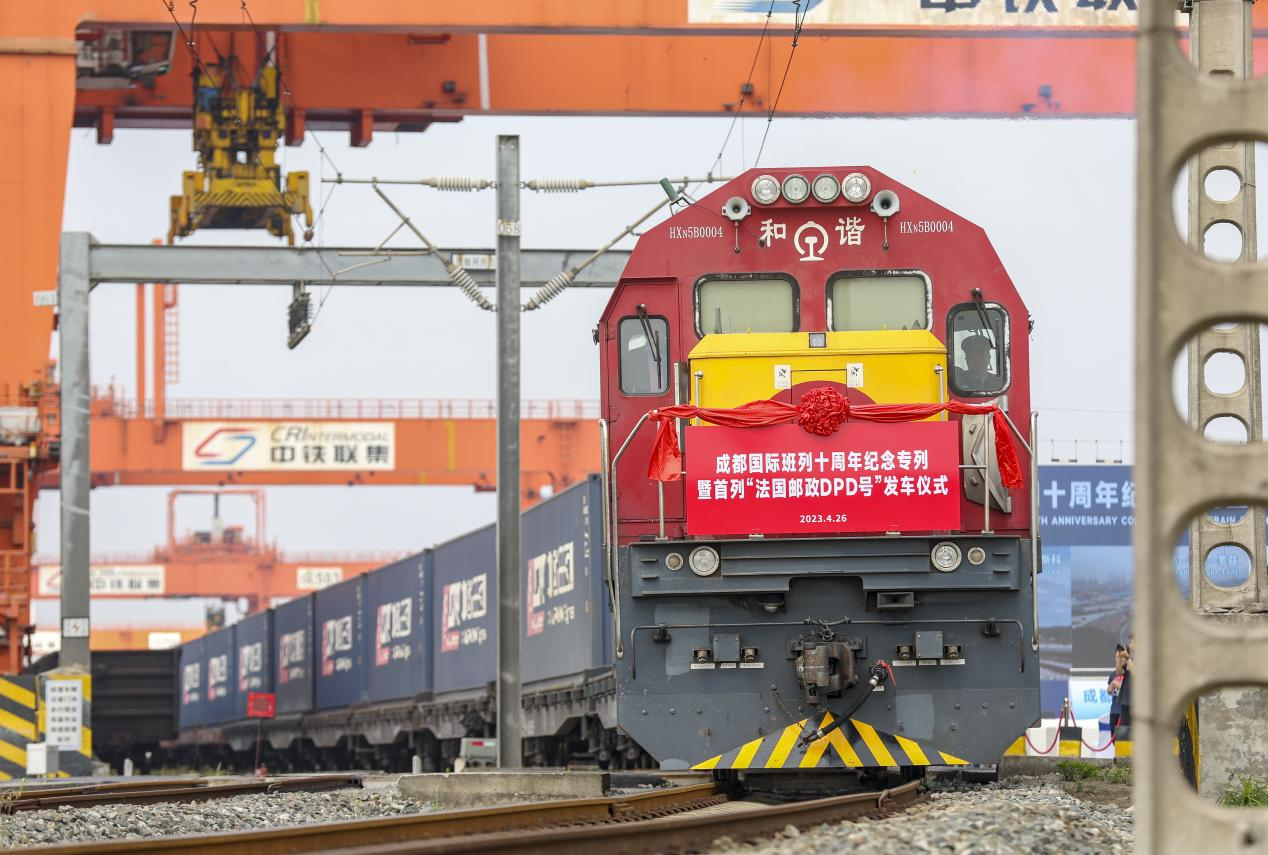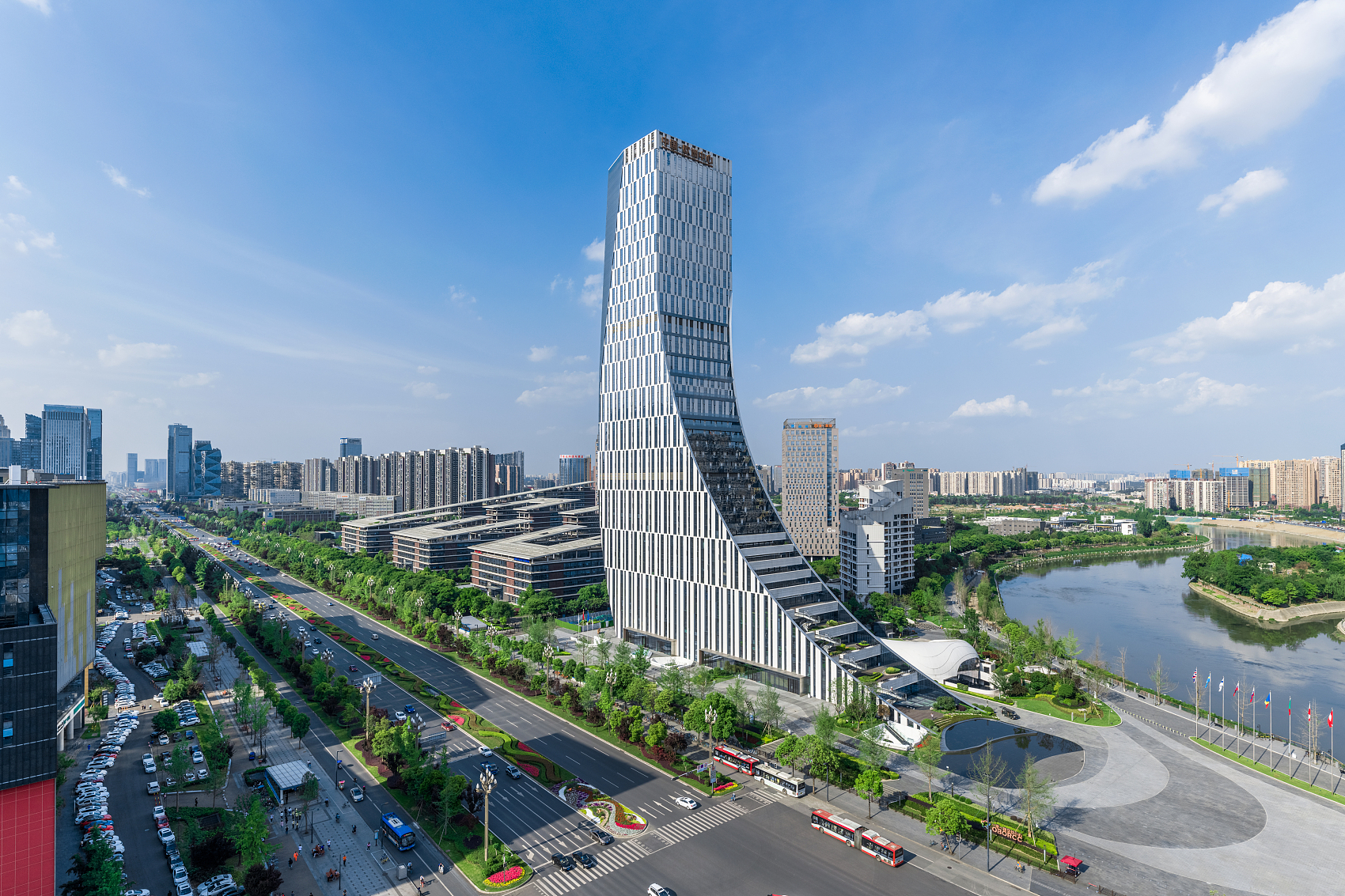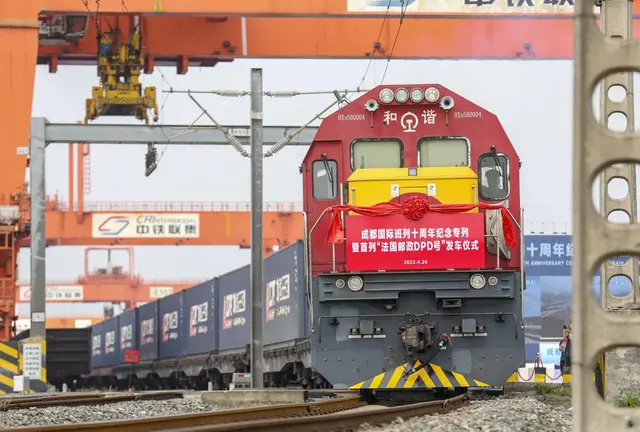Thousands of years ago, specialties from the Sichuan region such as Shu brocade, lacquerware and tea were sold along the ancient Silk Road to Central Asia, Western Asia and Europe. Today, via the “modern Silk Road” — a transportation network that consists of international train services and cargo flights, high-tech products produced in Chengdu, such as laptop chips, iPads, smart projectors and motor vehicles are being exported in large quantities to destinations worldwide.
Despite the passage of time and changes across the world, Chengdu’s open-mindedness and its pursuit of progress remain firmly in its DNA.
As a trading hub along the ancient Silk Road, Chengdu was considered to be on the periphery of international trade due to its inland location when the Age of Discovery began. However, with the introduction of the Belt and Road Initiative and China’s ongoing efforts to open up to the world, Chengdu has embraced this opportunity and worked diligently to enhance its channels and platforms for global communication and cooperation. As a result, Chengdu has rapidly emerged as a prominent inland hub for international exchanges and cooperation, while serving as a crucial gateway for China’s collaboration with countries and regions to its west and south.
In recent years, Chengdu’s economic strength has grown continuously, making it a leader among China’s “new first-tier cities”. In 2022, Chengdu achieved a GDP of 2.08 trillion yuan ($288 billion). This milestone has placed Chengdu as the seventh city on the Chinese mainland to surpass the 2 trillion yuan threshold.
New Silk Roads
Located inland and distant from both coastlines and borders, Chengdu is situated 1,700 kilometers away from the nearest seaport. In April 2013, the first Chengdu-Europe railway express (later renamed as the “China-Europe freight train”) departed from Chengdu International Railway Port and traveled along a transnational rail route spanning 9,826 km, straight to Lodz, Poland. This railway link has provided a fast and convenient land bridge for trade between Asia and Europe, putting an end to the days when China’s western regions had to rely solely on seaports for outbound trade.

An international freight train departs from the Chengdu International Railway Port. [Photo provided to China Daily]
In the past decade, the China-Europe freight trains departing from Chengdu have emerged as a shining star in the national China-Europe freight train network. This can be attributed to advantages such as high frequency, extensive coverage and efficient transportation. The transit time of these trains has been reduced from the initial 22 days to as fast as 10 days, while the value and volume of goods transported have shown significant increases.
Compared to sea and air transportation, the China-Europe freight trains offer a transportation cost that is one-fifth of air freight and a transit time that is one-fourth of sea freight. These trains ship out “Made in China” and “Made in Sichuan” products such as electronics, automobiles and machinery to various countries, while also bringing in German automobiles, French wines, Russian timber, Polish beef, Italian furniture and more. This has reshaped the foreign trade landscape of Chengdu and even western China.
The trains departing from the Chengdu International Railway Port are not limited to China-Europe freight trains. In response to a growing demand for cross-border logistics and international transit between Sichuan and members of the Association of Southeast Asian Nations, Chengdu has expedited the launch of southward international train services.
In 2022, Chengdu launched the China-Vietnam train service and the China-Laos train service. In June, the China-Myanmar New Channel (Mandalay-Chengdu) intermodal train service commenced operations, connecting Chengdu with Southeast Asia through the Yunnan Tengchong Houqiao Port.
Currently, Chengdu’s international train services reach 100 overseas cities and 30 domestic cities, establishing an international train network and land-sea freight distribution system with Chengdu at its core. They extend westbound to Europe, northbound to Mongolia and Russia, eastbound to Japan and South Korea, and southbound to ASEAN countries.
As Chengdu’s land transportation network continues to expand, its aviation logistics system is also scaling new heights, connecting Chengdu to the rest of the world and serving as a vital growth driver.
In June 2021, Tianfu International Airport, the largest public airport constructed in China during the 13th Five-Year Plan (2016-20) period, was put into operation in Chengdu. With the opening of this airport, Chengdu became the third city on the Chinese mainland, after Shanghai and Beijing, to have two international airports, accelerating its transformation into an international hub city.
In 2022, Chengdu Shuangliu International Airport and Chengdu Tianfu International Airport together handled a total of 31.09 million passengers, ranking Chengdu as the top city on the Chinese mainland in terms of passenger traffic. The international and inter-regional cargo and mail throughput reached 221,000 metric tons, marking a significant growth rate of 53.7 percent and reaching an all-time high.
On June 27, on its second anniversary since commencing operations, Chengdu Tianfu International Airport, in collaboration with the Chengdu port and logistics office, announced the launch of six new international routes for the summer transport season. These routes connect Chengdu to Sao Paulo, Istanbul, Kuala Lumpur, Colombo, Manila and Langkawi. Additionally, the airport would increase the frequency of seven international and regional routes.

A Boeing 747-8F all-cargo plane that took off from Santiago, Chile, is welcomed at Chengdu Shuangliu International Airport. [Photo provided to China Daily]
Platform for open cooperation
Chengdu, as a hub for international rail and air transport, is improving and expanding its networks in order to enhance connectivity and engagement with the global market. Efforts are being made to enhance platforms for open cooperation and foster an open economy.
The key area of the Chengdu International Railway Port primarily focuses on three areas: international supply chain, international trade and intelligent manufacturing in close proximity to the port. This location has attracted more than 200 projects, with a total investment exceeding 120 billion yuan. TCL Optoelectronics Technology (Chengdu), located in the Comprehensive Bonded Zone of Chengdu International Railway Port, utilizes the zone’s bonded function to produce essential components such as TV modules in the form of processing trade. These components are then transported to TCL’s assembly base in Poland via the China-Europe freight train service.
“The company has transferred 80 percent of its European orders to Chengdu, hoping to respond more quickly to the needs of European customers through the China-Europe freight train service,” said Sun Xiuhong, head of TCL’s Chengdu branch.
“More than 90 percent of the components required for TCL’s six production lines at the assembly base in Poland pass through the China-Europe freight trains departing from Chengdu,” Sun added.
The Chengdu-Eurasia National (Commodity) Pavilion, located at the Chengdu International Railway Port, is home to 34 venues operated by businesses from Europe, Central Asia, Southeast Asia, Oceania and other regions. These venues display and sell a diverse array of products, such as food and wine, maternity and child healthcare items, cosmetics, and motor vehicles. The pavilion generates an annual import transaction volume exceeding 1 billion yuan.
With Tianfu International Airport and Shuangliu International Airport, Chengdu is actively developing its airport economy to create new impetus for open development.
In the Shuangliu Area of the Chengdu International Airport Economic Zone, European aircraft manufacturer Airbus is constructing its first aircraft life cycle services center outside of Europe.
“The project is slated for operation by the end of the year and will provide one-stop services encompassing aircraft parking, storage, maintenance, upgrades, modifications, dismantling and recycling,” said a representative from the administrative committee of the Chengdu Shuangliu Aviation Economic Zone.
The Shuangliu Area, with a planned area of 4.98 square kilometers, aims to develop an aviation industry worth more than 20 billion yuan by 2025. Currently, three industry-leading enterprises, namely Airbus, the Commercial Aircraft Corporation of China and SF Express have established a presence in this area, along with 26 projects. Furthermore, it houses four functional platforms, including the Civil Aviation Airborne Equipment Airworthiness Certification Center.
The Eastern New Area of the Chengdu International Airport Economic Zone has a planned area of 9.3 sq km. It has initially established three industrial clusters —aviation logistics, aviation maintenance and manufacturing, and airside consumption. Around these three industrial clusters, the area has prepared a large number of projects.
The Eastern New Area has secured contracts to establish a base for industrial headquarters and the western China headquarters of Hymson, a major player in intelligent laser equipment manufacturing. Construction has already begun.
In addition, a demonstration zone for innovative civil aviation technology, involving more than 10 billion yuan in investment, will create a world-leading platform for advancements in civil aviation technology, as well as a research and development center for critical technology and equipment, with the ultimate goal of fostering a “smart valley” for the Chinese civil aviation industry.

The Business and Innovation Centre for China-Europe Cooperation has attracted some 200 institutions and enterprises. [Photo by Zhang Jian / For China Daily]
In Chengdu, there are cooperation parks with multiple countries, including France, Germany, Singapore, Italy, South Korea and Japan. These parks, along with other open cooperation platforms such as the China (Sichuan) Pilot Free Trade Zone and the Business & Innovation Centre for China-Europe Cooperation, are constantly strengthening their capacity to attract and allocate high-end resources.
Chengdu, with its remarkable strengths in international cooperation, has forged economic and trade connections with more than 200 countries and regions. According to figures from the Chengdu investment promotion bureau, foreign direct investment in Chengdu reached $2.59 billion in 2022, ranking it among the top destinations in China’s central and western regions; the number of Fortune Global 500 companies in Chengdu increased to 315.
With the expansion of channels for opening-up and increased economic and trade exchanges, Chengdu’s international connections have been rapidly expanding. As of June, Chengdu had established sister city relationships or friendly cooperation with more than 100 cities; it had been approved to host 23 foreign consular offices, ranking third among cities on the Chinese mainland and first in the central and western regions.
(CHINA DAILY)
 简体中文
简体中文

